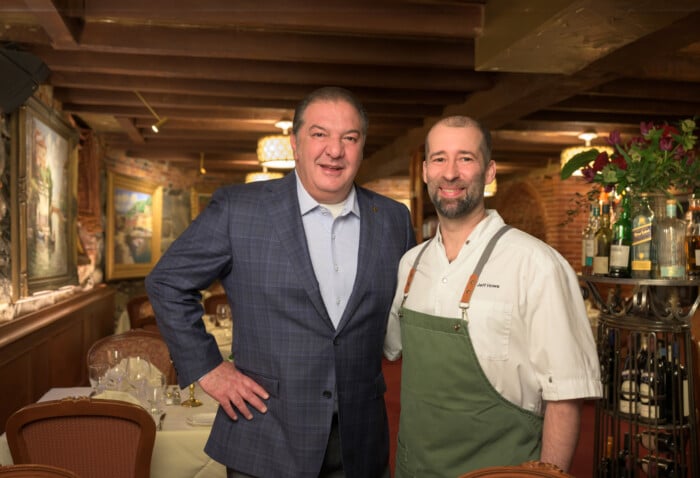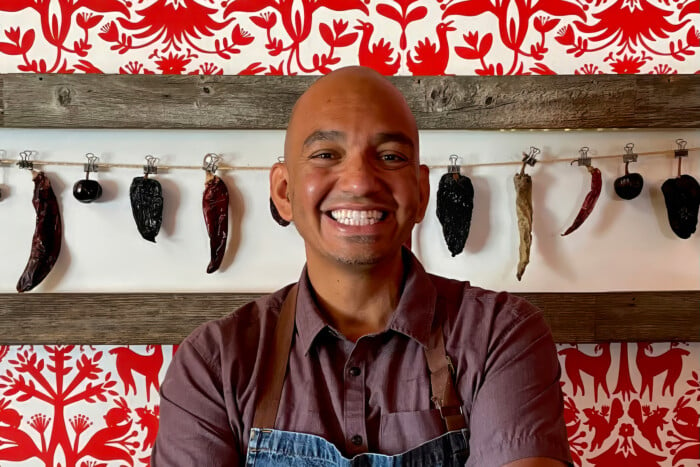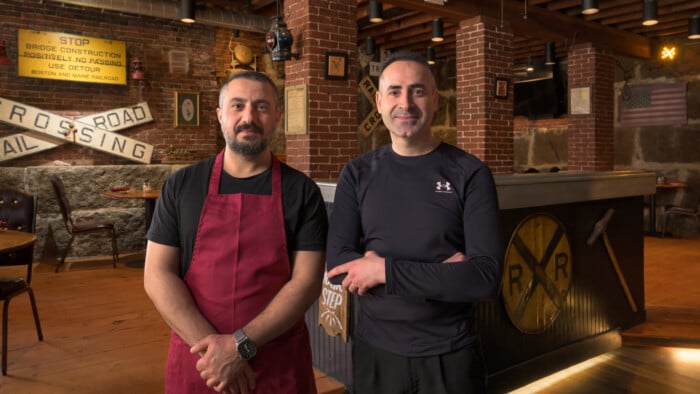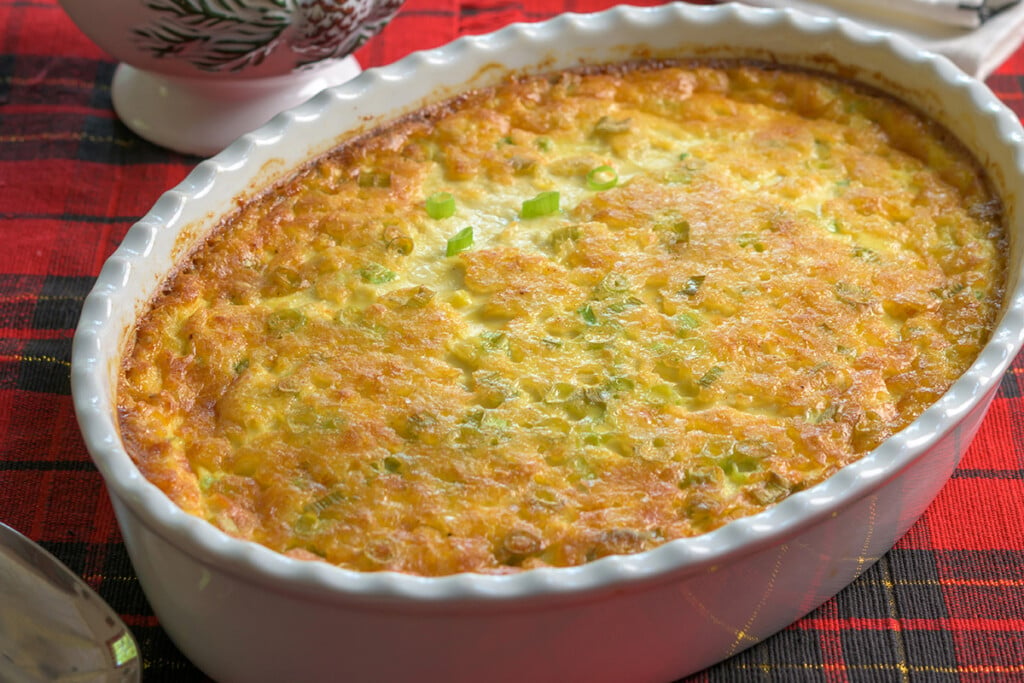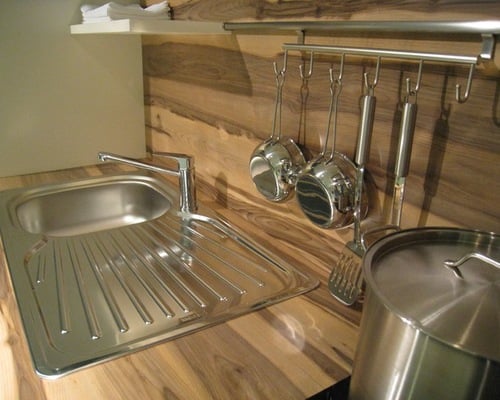Signor Hospitality!
From innovative concepts to timeless Italian favorites, each dish at Ristorante Massimo is handcrafted and made with care.
Greeting guests like family, with a kiss, a hug or a handshake, Massimo Morgia, owner of Portsmouth’s Ristorante Massimo, is in his element as he personally welcomes diners to his world of authentic Italian cuisine. Guests can expect both well-prepared food and hospitality reminiscent of a past era. The main dining room, elegant without being stuffy, is cozy with old-world charm that makes you feel like you could be in Italy.
Massimo was born in Pontecorvo, near Rome. You could say that his love affair with food is rooted in his DNA. Growing up in a family that grows their own vegetables, makes their own cheese and cures their own meats can spoil one for life and raise the bar for quality. At age 12, he knew his way around a restaurant kitchen, tackling a variety of jobs that, years later, led him to own his own restaurant.
For Massimo, food is more than sustenance — it is a bridge between generations, a keeper of traditions and a language of love. Around the table, families reconnect, share stories and solve a lot of problems.
Ever the creative thinker, Massimo even transformed his outdoor space into a comfortable living room with tables, plants and chairs to accommodate diners during the pandemic.
In our fast-paced, impersonal world, it’s nice to know that an element of generosity and care shows itself in each dish put before Ristorante Massimo’s dinner guests.
Mary Ann Esposito [MAE]: You have said that food is the essence of life. How is that exemplified at Ristorante Massimo?
Massimo Morgia [MM]: Food has always been at the heart of my life. Growing up, many of my family’s traditions centered around food — growing vegetables, pickling, making soppressata and sausages, jarring tomato puree and preparing Sunday dinners. Food is central to cultural and familial rituals; it strengthens our bonds and creates shared experiences.
MAE: You focus on the authentic dishes of Italy. Is there a particular region you favor?
MM: I was born just outside of Rome, and my grandmother lived in the heart of the city, so the Lazio region holds a special place in my heart. Many of our recipes come from this area. Our pasta carbonara is a family recipe, and our meatballs are made just like my mom used to make them.
MAE: How difficult is it to source authentic Italian ingredients?
MM: It’s not too difficult for us — we’ve built strong relationships with amazing vendors over the years. But authenticity in Italian cuisine isn’t just about importing ingredients; it’s also about philosophy. We use the best, freshest, local ingredients available and treat them with the care and respect they deserve.
We make our pasta fresh daily, butcher meats, craft our own sausage and buy local seafood all in small batches — just as many small regional restaurants in Italy do.
MAE: What do you wish your guests will take away from an experience at Massimo’s, besides the delicious food?
MM: Beyond the food, I want guests to feel the warmth of our hospitality —to feel welcomed, valued and seen. It is the whole experience that is important to me, and the genuine feedback from our guests is what motivates me every day. At times, their unsolicited, positive remarks make me emotional, still. Our goal is to create that feeling of receiving more than expected and always doing so with grace. Whether it’s someone’s first time, or they’ve been dining with us for years, we want every guest to feel like they’ve had a uniquely memorable and personal experience filled with genuine hospitality.
MAE: Portsmouth has seen an explosion of new dining establishments. Being a restaurateur is a constant challenge. How do you keep things new and competitive?
MM: We’re celebrating 30 years in business, and it’s an incredible honor to be part of this community — I feel so blessed — but you must stay current and create a company culture of learning, caring for one another. We succeed best when our culture allows us to make hospitality feel like home.
Each afternoon, we hold a pre-service meeting at 4:15. We review who’s coming in — first-time diners or longtime regulars — and go over any special occasions we can help celebrate. We keep detailed notes in our reservation system to personalize the experience.
I stay inspired by dining out, reading and listening to restaurant podcasts, being part of and involved in the community.
Our executive chef, Jeff, and his team are brilliant, passionate and caring. They are always introducing new and exciting creations, and they always prepare our classic and iconic dishes with love.
Stuffed Squash Blossoms
Stuffed zucchini blossoms are prepared with a variety of fillings. An iconic Italian dish, especially in summer, zucchini blossoms are sold at farmers markets and in grocery stores.
For the filling:
½ cup plain goat cheese
2 tablespoons mascarpone cheese
1 teaspoon fresh thyme leaves, finely chopped
Sea salt, to taste
For breading:
½ cup flour
2 eggs, beaten
1 cup panko breadcrumbs
Sea salt
For deep-frying:
Canola oil
For the salad:
1 small head frisée lettuce, washed and dried
1-2 radishes, thinly sliced
1 small bunch Candysnap or Muscat grapes
1 small piece fresh honeycomb (optional)
Edible flowers or microgreens, for garnish
For the vinaigrette:
2 teaspoons honey
1 teaspoon fresh thyme, chopped
1 tablespoon chardonnay or white wine vinegar
2–3 tablespoons extra virgin olive oil
Sea salt to taste
- Prepare the cheese filling. In a medium bowl, combine the goat cheese and mascarpone. Whip until smooth and well blended. Stir in chopped thyme and sea salt, to taste. Transfer the filling to a piping bag and set aside.
- Stuff the blossoms. Carefully open each zucchini blossom and remove the stamens. Pipe a small amount of cheese filling into each blossom, gently wrapping the petals around the filling and pinching the top closed. Be careful not to overfill.
- Prepare the breading. In a food processor, pulse the panko breadcrumbs with a pinch of sea salt until fine. Set up a breading station with three shallow bowls: one with flour, one with the beaten eggs and one with the seasoned panko.
- Bread the blossoms. Dredge each stuffed blossom in flour, tapping off any excess. Dip into the beaten eggs, coating completely. Then press into the panko, ensuring full coverage. For any bare spots, repeat the egg and panko steps. Set aside on a tray.
- Fry the blossoms. Heat canola oil in a deep pot to 325°F. Fry the blossoms in batches, gently submerging and turning them to ensure even cooking. Fry until golden brown and crisp, about 2–3 minutes. Remove and drain on paper towels. Season lightly with sea salt while still hot.
- Make the vinaigrette. In a small bowl, whisk together the honey, thyme and chardonnay or white wine vinegar. Slowly drizzle in olive oil while whisking until emulsified. Season with sea salt, to taste.
- Assemble the salad. Toss the frisée and sliced radishes with a small amount of vinaigrette and a pinch of sea salt. Arrange a portion on each plate and nestle in a piece of honeycomb (optional). Lightly grill the grapes until just blistered and add to the plate.
- Plate and garnish. Place 2 warm stuffed blossoms on each plate alongside the salad. Drizzle with olive oil and garnish with edible flowers or microgreens. Serve immediately.
Beet Agnolotti
 Serves 4 (approximately 20 agnolotti)
Serves 4 (approximately 20 agnolotti)
Agnolotti are ravioli from the northern region of the Piedmont and are served as a first course.
Roasted Beets:
2 large red beets
1 large candy cane (Chioggia) beet
2 oranges, zested and quartered
6 – 8 sprigs fresh thyme
Sea salt
Pasta Dough:
1½ cups (approximately) all-purpose flour or 00 Italian flour
Pinch of sea salt
6 – 7 large egg yolks (adjust as needed for dough consistency)
Sauce and Garnish:
1 candy cane beet (roasted, peeled and diced)
1 tablespoon olive oil
1 tablespoon chopped parsley
2 shallots, finely chopped
2 sprigs fresh thyme
¼ cup dry white wine
4 – 6 tablespoons unsalted butter (cubed and chilled)
1 teaspoon chopped fresh tarragon
Sea salt, to taste
2 tablespoons toasted pistachios, crumbled
Beet shoots or microgreens, for garnish
- Roast the beets. Preheat oven to 400°F. Line two small baking dishes with a layer of sea salt. Place red beets in one dish and candy cane beets in the other. Add quartered oranges and thyme sprigs to each dish. Cover the beets with more salt, then cover tightly with foil. Roast for 45 – 60 minutes, or until a skewer easily pierces
the beets. Let cool slightly, then peel the beets by rubbing the skins off with a towel. Keep red and candy cane beets separate to preserve their color.
- Prepare the filling. In a food processor, combine the peeled red beets, mascarpone and reserved orange zest. Blend until smooth. Season with sea salt to taste. Transfer the mixture to a pastry bag and refrigerate until ready to use.
- Make the pasta dough. In a stand mixer fitted with a dough hook, combine the flour and a pinch of sea salt. Slowly add egg yolks into the center while mixing until a dough forms. Turn the dough out onto a lightly floured surface and knead by hand for 5 minutes. Wrap in plastic and rest at room temperature for 30 minutes.
- Form the agnolotti. Working in batches, roll the rested pasta dough through a pasta machine to desired thinness. Pipe small dollops of beet filling in a line down the center of the sheet, spacing evenly. Fold the pasta over the filling, pressing to seal. Use a fluted cutter or knife to form agnolotti. Dust with flour and rest on a tray.
- Prepare the garnishes. Dice the roasted candy cane beet and toss with olive oil, chopped parsley and sea salt. Warm gently in the oven before serving.
- Make the sauce. In a small saucepan, melt 1 tablespoon butter. Add shallots and thyme sprigs, and sauté over medium-low heat for about 3 minutes. Deglaze the pan with white wine and reduce by a little more than half. Lower the heat and whisk in the remaining chilled butter, a few cubes at a time, to create an emulsified sauce. Remove thyme sprigs. Season with salt and chopped tarragon.
- Cook and plate. Bring a large pot of salted water to a boil. Cook the agnolotti for 2–3 minutes, or until they float and are tender. Transfer to the pan with the butter sauce and toss gently to coat. Plate the pasta with additional sauce. Top with warm candy cane beets and crumbled toasted pistachios. Garnish with beet shoots or microgreens.


